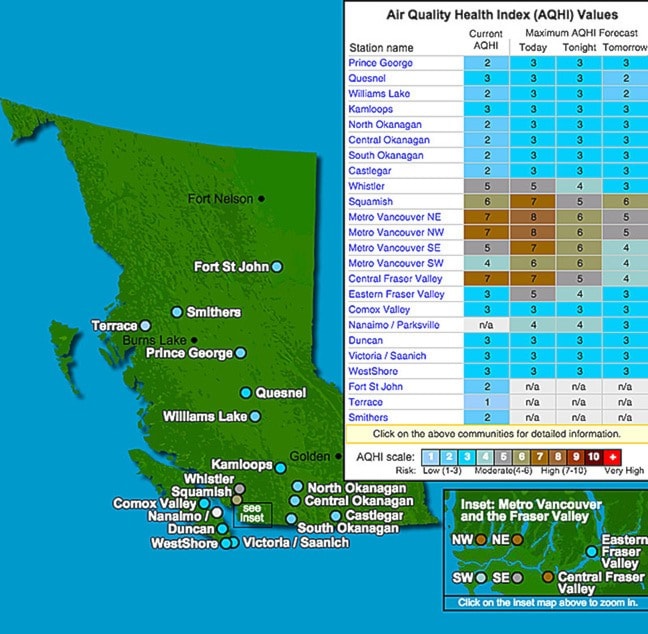Terry Farrell
Record staff
From an air quality standpoint, it’s not as bad as it looks in the Comox Valley.
“In the Valley right now, I know people can see the haze and the smoke, but the air quality advisory … our air quality for the health index, is about a three,” said Charmaine Enns, Island Health’s North Island’s medical health officer. “It could go up to a four today. The scale is from one to 10, with 10 being the (worst).”
Enns recommends that everyone with access to the Internet go to the air quality website at www.bcairquality.ca and check the chart.
“It’s a very good source for people to use,” she said.
Island Health is advising people with health issues to be aware of the conditions.
“What matters is that the people who are most at risk know that the air is not good - but they know that before the rest of us; they can feel their symptoms,” said Enns. “The air quality as it is in the Comox Valley right now, the general population probably will not be impacted in their day-to-day living and in what they are doing. If the air quality gets worse...people just need to be aware about avoiding strenuous activity outside, and limiting your exposure.”
She added those who fall into the age extreme categories - young children and seniors - will be the most impacted.
“The very young, the seniors, and the people who have underlying heart and lung disease especially,” said Enns. “The particulate matters in the air, those particles actually create an inflammatory response in our airways and our blood vessels. So that’s why people with heart and lung disease are so impacted.
“So we particularly want those people to know that, if they can avoid outdoor exposure, then great.”
Environment Canada’s Air Quality Health Index considers 1-3 on the scale to be of low health risk, but Enns did warn not to take the chart too lightly.
“If you can smell it and you can see it, that means it’s real,” she said. “So regardless of what the monitor is saying … (most of us) are going to be fine, but for my dad, who has had several heart attacks, (going outdoors) might not be so good.”
She also noted that residents can expect more of this as the summer progresses.
“This story isn’t going away,” said Enns.
“We are on for a hot, dry summer, and there is no reason for any of us to think that this is going to be a one-weekend deal.”
Earle Plain, and air quality meteorologist at Ministry of Environment, said compared to other communities on the Island, the Comox Valley is not that bad off.
“Looking at your numbers, they are actually pretty good,” he said. “There have been a few peaks but nothing compared to the lower Island. My analyzer here in Nanaimo actually over-ranged, which means it wasn’t set up to register the numbers that we experienced.”
Plain said the current air quality conditions on Vancouver Island are similar to those of 2010, when smoke from Okanagan wildfires reached the Island.
“The outflow from those fires drove the smoke across the strait towards the Island, but it didn’t build up the same way,” he said. “You could see the smoke and we had the high readings, but not like this. These are the highest numbers I have seen, especially in Nanaimo.
“We are really looking at Mother Nature to help change things here and right now and best guess right now is… maybe Wednesday, we might see a bit of a low cold front push through. But really, it’s going to be wind directional related and unfortunately right now we are kind of surrounded on all fronts.”
